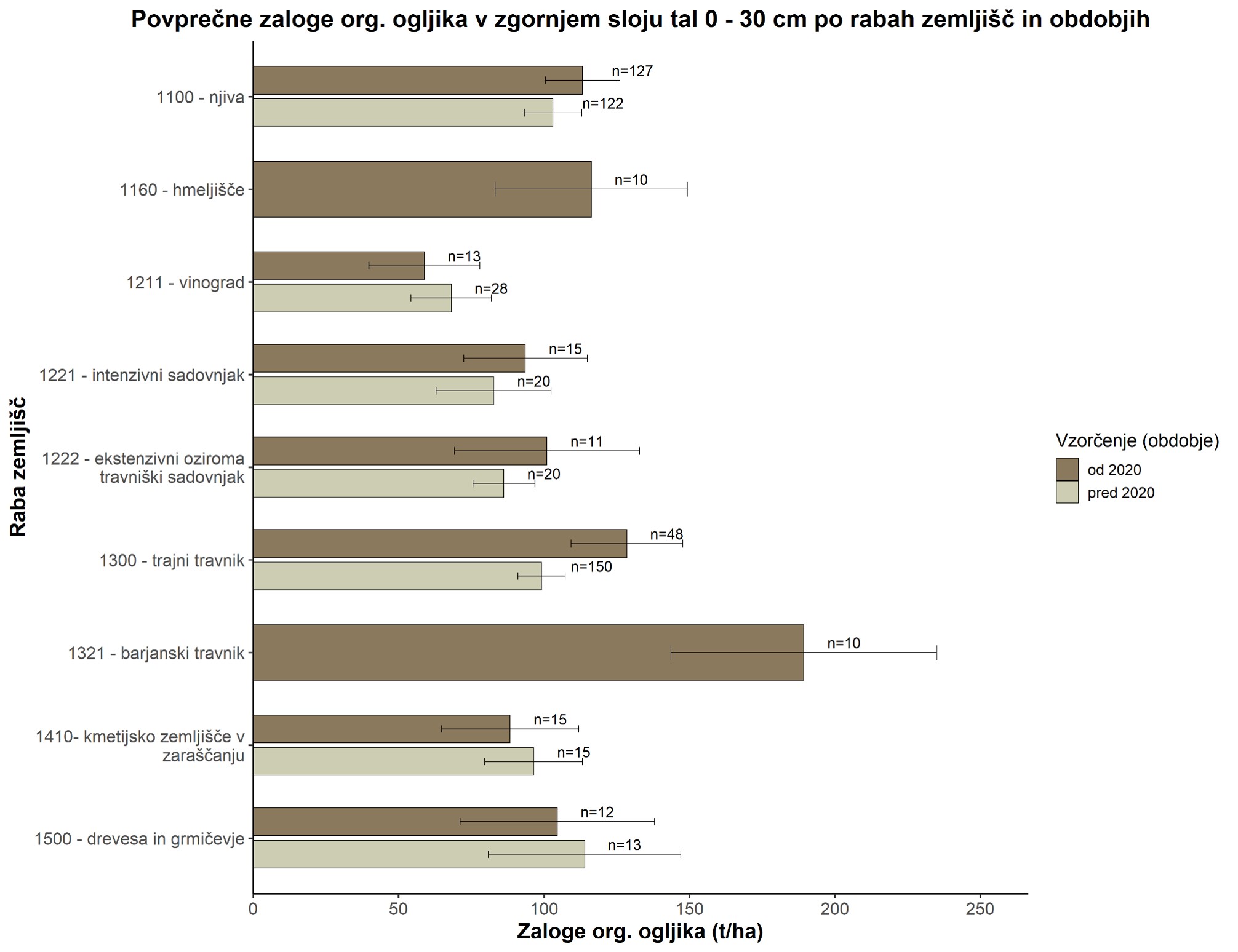[KM36] Soil organic carbon stocks

Key message

Overall, the data confirm a clear distribution of carbon stocks by land use: organic/peat-influenced soils and uses with permanent vegetation cover (peatland meadows, permanent grasslands, tree- and shrub-dominated vegetation) reach the highest stocks (approximately 105–190 t/ha, with peatlands at the top). These are followed by extensive orchards (around 100 t/ha), while intensive orchards and vineyards remain in the lower range (approximately 59–94 t/ha). Arable land falls within the medium range, but shows signs of an increase after 2020 (113.3 t/ha). It should be noted that some categories (e.g. peatland meadows, hop fields) are supported by a limited number of measurements, and therefore additional sampling is recommended to obtain more robust estimates. From a management perspective, the results emphasize the value of maintaining permanent soil cover and minimizing disturbance, as well as the critical need to protect organic soils (mainly those of peatland meadows).
Definition
The indicator shows the average SOC stocks, which were calculated following the formula of Lefèvre et al. (2017) from measured values in soil samples collected at representative sites within the following agricultural land-use categories:
- 1100 – arable land
- 1160 – hop field
- 1211 – vineyard
- 1221 – intensive orchard
- 1222 – extensive or meadow orchard
- 1300 – permanent grassland
- 1321 – peatland meadow
- 1410 – agricultural land under succession
- 1500 – trees and shrubs
Although soil sampling was not repeated at the same sites, the data were divided into two time periods and are presented as averages for the respective land-use categories by period:
- before 2020,
- from 2020 onwards.
The assessment of SOC stocks in agricultural soils serves as an indicator of sustainable use of agricultural land, soil fertility maintenance, and the contribution of agriculture to climate change mitigation.
Charts
AIS, soil database eTLA.
| Average before 2020[ha] | average after 2020[ha] | med before 2020[ha] | med after 2020[ha] | n before 2020[ha] | n after 2020[ha] | |
|---|---|---|---|---|---|---|
| 1500 – Trees and shrubs | 113.96 | 104.59 | 109.90 | 98.34 | 13 | 12 |
| 1410 – Agricultural land under succession | 96.46 | 88.38 | 85.65 | 84.49 | 15 | 15 |
| 1321 – Peatland meadow | 189.33 | 183.53 | 10 | |||
| 1300 – Permanent grassland | 99.21 | 128.50 | 90.61 | 123.76 | 150 | 48 |
| 1222 – Extensive or meadow orchard | 86.23 | 101.05 | 81.35 | 93.26 | 20 | 11 |
| 1221 – Intensive orchard | 82.69 | 93.65 | 69.58 | 76.72 | 20 | 15 |
| 1211 – Vineyard | 68.14 | 58.88 | 61.67 | 50.81 | 28 | 13 |
| 1160 – Hop field | 116.24 | 124.02 | 10 | |||
| 1100 – Arable land | 103.11 | 113.29 | 85.23 | 85.74 | 122 | 127 |
Goals
- Retaining and, where possible, increasing the content of soil organic matter (SOM) / organic carbon stocks in the upper soil horizons of all types of agricultural land use.
- Ensuring sustainable food production and supply with minimal soil water erosion.
- Enhancing soil ecosystem services directly related to SOM.
Comment
The highest average in the entire dataset is found in peatland meadows (1321), with 189.3 t/ha recorded in the period from 2020 onwards (n=10). This value confirms that organic soils represent key areas of exceptionally high carbon storage, although the limited sample size requires cautious interpretation. Among land uses with permanent soil cover, permanent grasslands (1300) stand out, where the mean increased from 99.2 t/ha (before 2020; n=150) to 128.5 t/ha (from 2020 onwards; n=48), representing an increase of approximately +29%. High carbon stocks were also measured under trees and shrubs (1500), although the mean decreased slightly from 114.0 to 104.6 t/ha (–8.2%; n=13 → 12), and in hop fields (1160), for which no earlier data are available but which averaged 116.2 t/ha after 2020 (n=10).
Within the group of semi-permanent uses with moderate management intensity, extensive or meadow orchards (1222) increased from 86.2 to 101.1 t/ha (n=20 → 11), highlighting the benefits of permanent grass cover and reduced soil disturbance compared to intensive systems. Agricultural land under succession (1410) had averages of 96.5 and 88.4 t/ha (–8.4%; n=15 in both periods), consistent with the transitional nature of this land use and heterogeneous substrate. In more intensive systems, carbon stocks were lower: intensive orchards (1221) increased from 82.7 to 93.6 t/ha (n=20 → 15), while vineyards (1211) decreased from 68.1 to 58.9 t/ha (–13.5%; n=28 → 13). Arable land (1100), with the largest number of samples (n=122 and 127), showed a moderate increase from 103.1 to 113.3 t/ha (+9.9%), which may reflect a broader adoption of conservation practices (cover crops, reduced tillage) or differences in the spatial distribution of sampled sites between the two periods.
Conservation tillage (i.e. reduced or minimum soil disturbance) and/or increased inputs of organic matter into soils promote greater accumulation of soil organic carbon and consequently reduce atmospheric CO₂, thereby contributing to climate change mitigation in the medium and long term. It is therefore crucial that measures within the Common Agricultural Policy are directed towards promoting sustainable agricultural practices, ensuring improved environmental protection and a stronger contribution of agriculture to climate change mitigation.
Key findings:
- Peatland meadows (1321) hold by far the largest soil organic carbon stocks (~189 t/ha), but due to the small sample size, cautious interpretation and continued monitoring are required.
- Vineyards (1211) and intensive orchards (1221) remain among the land uses with the lowest carbon stocks (59–94 t/ha), consistent with the effects of more intensive management and frequent soil disturbance.
- Arable land (1100) lies in the medium range (approx. 103–113 t/ha), but results after 2020 suggest a slight increase.
- Given the large sample size, temporal differences can be assessed with greater confidence for arable land and permanent grassland. In both cases, carbon stocks appear to be increasing. Note: temporal differences between periods should be regarded as indicative only, since sampling was not repeated at the same locations.
Methodology
Lefèvre, Clara, Fatma Rekik, Viridiana Alcantara Cervantes, in Liesl Wiese. 2017. Soil Organic Carbon: The Hidden Potential. Global symposium on soil organic carbon, Rom. Food and Agriculture Organization of the United Nations.
MKGP. 2007. Pedološka karta Slovenije 1:25.000, MINISTRSTVO ZA KMETIJSTVO, GOZDARSTVO IN PREHRANO. ESRI shp. MKGP. 1:25.000.









